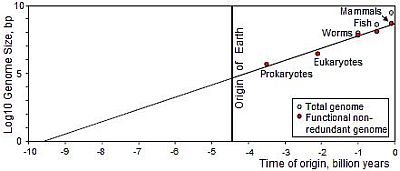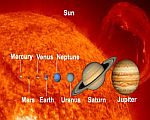Humanoid Aliens? Do intelligent extraterrestrials have to look like us?
Humanoid aliens seem to be the norm in science fiction TV and motion pictures. Let's face it, it's simpler and cheaper to put an actor in a monster suit than to create a totally non-humanoid being from scratch. Such excellent films as 2001: A Space Odyssey and Contact avoided the problem entirely by never showing the aliens. But is the humanoid form - body, head, two arms and two legs - necessarily the optimum arrangement for an intelligent extraterrestrial life form?
Well, let's see...
The Difference Between "Sentient" and "Intelligent"
Roughly speaking, the term "sentient" means possessing consciousness. Thus there are many many species on this planet that could be considered to have this quality. Intelligence, on the other hand, implies the ability to create some sort of technology and civilization. Possessors of this quality would have the ability to plan ahead, utilise thought processes and communicate. There is only one such species on Earth able to do this - humans.
Although certain animals - the dolphin and the octopus for example - are considered "intelligent", they should more correctly be described as "sentient".
The Body Plan
So, to investigate whether the optimum body plan throughout the Universe would result in the humanoid alien, let's discuss what's required to result in "intelligent life".
For a start, all multicellular life forms will have to metabolise in order to live. That is to say, they will have to take in fuel (i.e. food) and expel waste. Thus, at its most basic, a life form will be essentially a tube with a mouth at one end and an aperture for expelling waste at the other.
To develop a technology, the life form must be a land dweller in order to utilise things like fire and electricity. Water-based life cannot, therefore, be considered. Also, avian intelligent life is unlikely. A large brain would be required and the hollow bone structure of bird-like creatures would hamper this.
Sense Organs
We've already seen that the basic "tube" will have to have a mouth at one end. Logically, this can be considered as the creature's front end. It makes sense that the other sense organs be in this area, too. It would need to be able to see, so eyes would be situated there. The optimum number would be two, for depth perception. (It would be very difficult to work with tools and technology without this.) Some aural sensors would be essential, to monitor the surroundings, so some form of ears would be necessary, preferably positioned either side of what has now become the "head" of the creature, to help to ascertain where a possibly threatening sound is coming from.
So far, then, we've got a snake-like creature, with a head at one end containing eyes, ears, mouth and nose. The head would also be the best location of the main part of its nervous system - the brain.
How Many Legs?
A snake-like creature, however much brain power it possesses, hasn't much chance of developing a technology, as it has no limbs to manipulate tools. Also, slithering around isn't the best form of locomotion. The possession of legs is pretty much a necessity. But, how many? For an intelligent extraterrestrial to be a humanoid alien, it would have to have two, along with two arms. But is this number of limbs the optimum arrangement?
Regarding legs, over the millennia that life has existed on Earth, there has been a tendency for the number of legs to reduce. These days, four seems to be the required number. All very well for most land animals, but non-load-bearing limbs are necessary for the humanoid alien to manipulate tools and create a technology. The requirement, then is for two (rear) legs to be retained for weight bearing and locomotion, with the other two becoming arms.
It's turning out to be pretty humanoid, this design, isn't it?
This is what some scientists think, anyway.
Panspermia
This is the name given to a theory that life didn't originate spontaneously on Earth, but arrived from space, in the form of microbes carried on meteorites. A study has been made on the rate of increasing complexity of the genome of various species and extrapolating backwards to find when it reaches zero (i.e. its time of origin).

Here's a graph of the result. As you can see, where the genome reaches zero is some five billion years before the Earth was formed, implying that it originated elsewhere.
A more fanciful version of this is the suggestion that an extremely advanced race of humanoid aliens may have deliberately seeded various planets in the galaxy with genetic programs that would eventually evolve life forms similar to them - again resulting in extraterrestrials being pretty similar to us in appearance. This, of course, is more the realm of science fiction.
Possible Non-Humanoid Aliens
Taking Earth as an example, the race of dinosaurs that existed in the distant past ruled the planet for some 160 million years, until they were killed off, chiefly by an asteroid impact about 65 million years ago. But, what if they hadn't become extinct? Mammals wouldn't have become the dominant species, so we humans would not exist. Such types of dinosaur as the velociraptor, that showed a modicum of intelligence (using strategy and teamwork to hunt) may have continued to evolve, becoming an intelligent, technologically advanced sauroid life form. Who's to say that other worlds aren't populated by "lizard people"?
If a similar life form to the octopus existed on other worlds, that had the necessary metabolism to survive on dry land, it could very well evolve sufficient intelligence to create a technology. As we know, the Earth octopus only has eight legs with no fingers (or should that be toes) on their ends. Who's to say an alien version won't have them, enabling it to manipulate tools? Now that would be a truly non-humanoid alien!
return to extraterrestrail life









Facebook Comments
Have your say about what you just read! Leave me a comment in the box below.